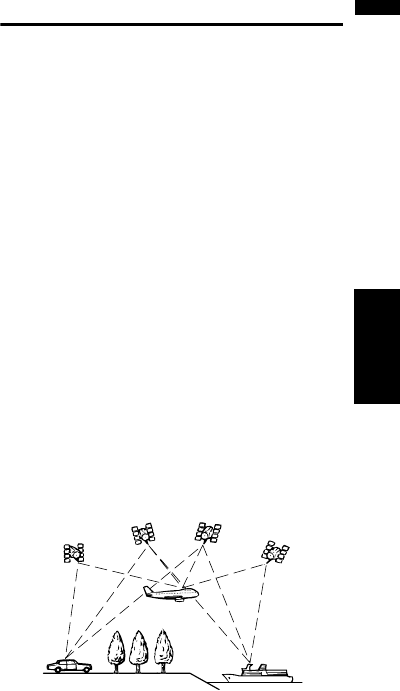
179
AppendixNAVI/AV
4 Press the V button.
The adjusted position data is saved.
❒ Do not turn off the engine while saving the
adjusted position data.
❒ Press the MAP button to complete the 4-
point adjustment.
5 Press the V button.
The 16-point touch panel adjustment screen
appears.
6 Gently touch the center of the + mark dis-
played on the screen with the touch panel
adjustment pen.
After you touch all marks, the adjusted posi-
tion data is saved.
❒ Do not turn off the engine while saving the
adjusted position data.
❒ Press the V button to return to the previ-
ous adjustment position.
❒ To cancel the adjustment, press the MAP
button.
7 Press the MAP button.
The adjustment is complete.
❒ If touch panel adjustment cannot be per-
formed properly, consult your local Pio-
neer dealer.
Positioning Technology
The navigation system accurately measures your
current location by combining the positioning by
GPS and by Dead Reckoning.
Positioning by GPS
The Global Positioning System (GPS) uses a net-
work of satellites orbiting the Earth. Each of the
satellites, which orbit at a height of 68 900 000
feet (21 000 km), continually broadcasts radio sig-
nals giving time and position information. This
ensures that signals from at least three can be
picked up from any open area on the ground’s
surface.
The accuracy of the GPS information depends on
how good the reception is. When the signals are
strong and reception is good, GPS can determine
latitude, longitude, and altitude for accurate posi-
tioning in three dimensions. But if signal quality
is poor, only two dimensions, latitude and longi-
tude, can be obtained and positioning errors are
somewhat greater.
Positioning by dead reckoning
The 3D Hybrid Sensor in the navigation system
also calculates your position. The current loca-
tion is measured by detecting driving distance
with the speed pulse, the turning direction with
the Gyrosensor, and inclination of the road with
the G sensor.
The 3D Hybrid Sensor can even calculate
changes of altitude, and corrects for discrepan-
cies in the distance traveled caused by driving
along winding roads or up slopes. Also, the navi-
gation system learns the driving conditions and
stores information in the memory; thus, as you
drive more, the precision of the positioning
becomes more accurate.


















